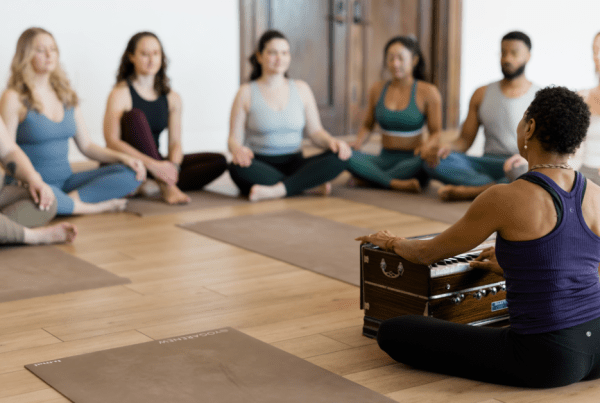
The Yoga Sutras of Patanjali is a text that’s included in 200 hour yoga teacher trainings almost everywhere, so you might think that the text is packed with some easy to follow concepts that are neatly packaged into a nice quick read.
At least, that’s what I thought too when I began my 200 hour teacher training years ago, so I was in for a surprise when I began to dive into the text!
I remember being overwhelmed with Sanskrit words I’d never heard, feeling more and more confused each time I turned a page, and wondering how any of it could be applied to my everyday life. It seemed like it was text for people who didn’t need to have a job or deal with conflict that came up with friends and family. I couldn’t understand why it was a part of my training.
It wasn’t until I read more commentaries, studied with more teachers, and expanded my own training that I started to realize how important The Yoga Sutras are to us as humans here on Earth today.
It’s no joke when someone tells you that these concepts need to be unpacked and discussed because they’re pretty hard to understand if you simply sit and read through the text on your own. At this point in my studies and teaching, I’m actually excited to talk about The Yoga Sutras and find ways to make the text as accessible and understandable as possible.
Here are a few points that will hopefully intrigue you and also give you some insight into the teachings:
The Yoga Sutras help eliminate human suffering
There are three different kinds of suffering: suffering caused by one’s body and mind, suffering caused by other beings, and suffering caused by natural disasters.
You can’t control everything that happens to you, but you can control how you respond. The purpose of The Yoga Sutras is to offer ways to understand the self and the universe so you can respond to the things you can’t control in a way that helps you learn more about yourself.
Patanjali didn’t create The Yoga Sutras
Although Patanjali’s name is on almost every copy of The Yoga Sutras, Patanjali didn’t come up with them.
It’s believed that there was a time when people could easily memorize information without reading or writing anything down and truth flowed freely from person to person without distraction. Very little is known about Patanjali, who is believed to have lived anywhere between 200 BCE to 500 CE, but it is believed that as people began to struggle to remember truthful information,
Patanjali was the one who took control of recording The Yoga Sutras. So he wasn’t the person who created them, but rather documented them.
Vyasa didn’t create The Yoga Sutras, either
Vyasa is another name you’ll probably come across as you study The Yoga Sutras and also most yoga philosophy. Vyasa existed around 500 CE and was the first to comment on The Yoga Sutras.
This Vyasa is not to be confused with the author of other texts throughout yoga philosophy, as it’s believed that they are different people. Some schools of thought also believe that Vyasa may actually be a title that was attained by a certain class of scholars. Either way, all later commentaries on The Yoga Sutras depend heavily on Vyasa’s.
There are many translations and commentaries on The Yoga Sutras
If you go to a bookstore or do an online search for The Yoga Sutras, you will probably find books of all sizes, translations that are slightly different, and commentaries that say things in various ways. This is because The Yoga Sutras are in Sanskrit and Sanskrit is incredibly difficult to translate directly.
It does a Sanskrit word a disservice to say that the word means this or that, so it’s better to think about the qualities the word embodies.
The Yoga Sutras have also been around for a very long time, so as this world changes, so do different concepts. In a more current commentary of the Yoga Sutras, the commentator may explain how the mind often sees experiences through a certain kind of covering similar to an Instagram filter. Years ago, this wouldn’t have made sense because there was no such thing as Instagram, so the commentator would have had to use a different example.
The first chapter is called The Samadhi Pada
The first chapter, or book, or “pada” in Sanskrit, presents you with the concept of creating clarity, distractions you may face, the outcome of distractions, and the fact that your mind is extremely powerful when you are able to remove obstacles, limitations, and anything that clouds it.
This chapter explains how the mind doesn’t always see the truth and how everyone on Earth seems to be walking around with their own versions of what is true. It outlines how anyone with a mind can either find themselves existing in sadness or bliss, depending on how well they have conquered their mind.
The second chapter is called the Sadhana Pada
In the Samadhi Pada, you are introduced to what clouds your mind, your self imposed obstacles, and the power your mind has.
In book one, you learn many of the principles of yoga. Then, the first 30ish Sutras of book two guide you to understand appropriate action. Much of the first part of book two can be seen as a guide to sitting with discomfort and using it to your advantage. It’s sometimes too easy to mask or move over what causes some kind of discomfort.
The second part of the Sadhana Pada introduces the 8 Limb Path. This path helps you improve yourself, your relationship with the world, your relationship with your mind, and with your emotions.
Vibhuti Pada and Kaivalya Pada are the third & fourth chapters
Most yoga teacher trainings only cover chapters one and two of The Yoga Sutras. This may be because the third and fourth chapters talk about things like special powers and abilities a person may attain from the practices in the previous chapters.
In the third book, you learn about the powers that come as bi-products of the yoga practice outlined in Books one and two and then in the fourth book, you will learn about the path of renunciation, detachment from material objects, and freedom from earthly desires.
The Yoga Sutras don’t always fit in to our daily life
After bringing up special powers and renunciation, you might be wondering how this fits into your day to day life where you have a job, a family, and responsibilities.
In short, it doesn’t.
The Yoga Sutras provide the information and the tools needed to understand the mind to take control of it. The text also discusses what can happen once the mind is controlled and you’re no longer responding to its every whim.
As beings here on Earth in this present day, it’s important to use the teachings of The Yoga Sutras to conquer the mind and realize the mind isn’t in control. Once this is realized, the possibilities to take control of your life are endless.
It’s all about: remember who you are
There are many themes throughout The Yoga Sutras and there are many threads that weave in and out of the text and other areas of Yoga Philosophy. Something that I’ve come to understand and love about all of it is that the teachings are meant to help me become a better person. They’re meant to help me move away from the suffering or pain that I often cause myself and move towards love and happiness. Yoga philosophy has provided insight into connecting with my purpose and why I’m here. It’s been the main force that’s helped me remember who I am.
It leaves much to be discussed
One of the coolest things about The Yoga Sutras is that they’re meant to be discussed. This text isn’t something you read, memorize concepts from, and then move on and forget all about it. It’s a text that’s supposed to move with you and you move through life and also a text that’s meant to be questioned. The sutras are small, quick, intelligent blurbs of wisdom that should be sat with, unpacked, and talked about with students, teachers, family, and friends. They’re for anyone who is willing to open up to them and attempt to use them as a way to have a life that’s a bit sweeter. There are lots of commentaries written on them because there is simply so much to say and so many questions to ponder.
As you study different areas of yoga philosophy, I invite you to move through each area with an open mind and an open heart. There are so many beautiful truths to the teachings that are present in lots of other philosophies around the world and seeing that common thread can be eye-opening when it comes to seeking answers. I have always been intrigued with The Yoga Sutras because the text is read and studied by so many beautiful yoga teachers and practitioners across the world.
The Yoga Sutras are a great place to pull information from as inspiration for your Dharma Talks.
If you want more tips on giving great Dharma talks, grab my free Dharma Talk Starter Kit.










